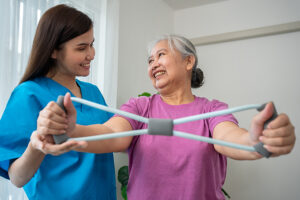We deal with a lot of changes in homecare. Part of our care means helping our clients through changes in their life and adjusting according to those changes. What happens if you or a loved one is experiencing mobility changes? Let’s talk about that today.

Talk to Your Doctor
Sometimes, I know that mobility changes can come after a diagnosis, but in the case that the person experiencing mobility changes does not have a current diagnosis, please bring this up with their doctor. This could be an early sign of something very serious. And your doctor can refer you to a physical therapist, if needed.
Stay Active
Staying active as long as possible will keep your body strong and can even help with mobility. This is another thing you can work with a physical therapist on. I wrote about great exercises for older adults here.
Work With the Changes
It can be easier to adjust to mobility changes by looking at the task at hand a little differently. This can mean using handrails when going up stairs, or using something like a shower chair to be able to shower independently. It can be easy for caregivers to jump in and try to perform whatever task themselves. However, it means that the client loses a little bit of their independence, perhaps prematurely. Maybe we switch to velcro shoes, maybe we start wearing shoes in the house to help with stability. Maybe we change how we get dressed so that we don’t have to twist or reach a certain way.
As we age, we often experience mobility changes. I have a little more to say on this, so maybe we’ll see a part two in the future.
Written by Brigid Stakelum



